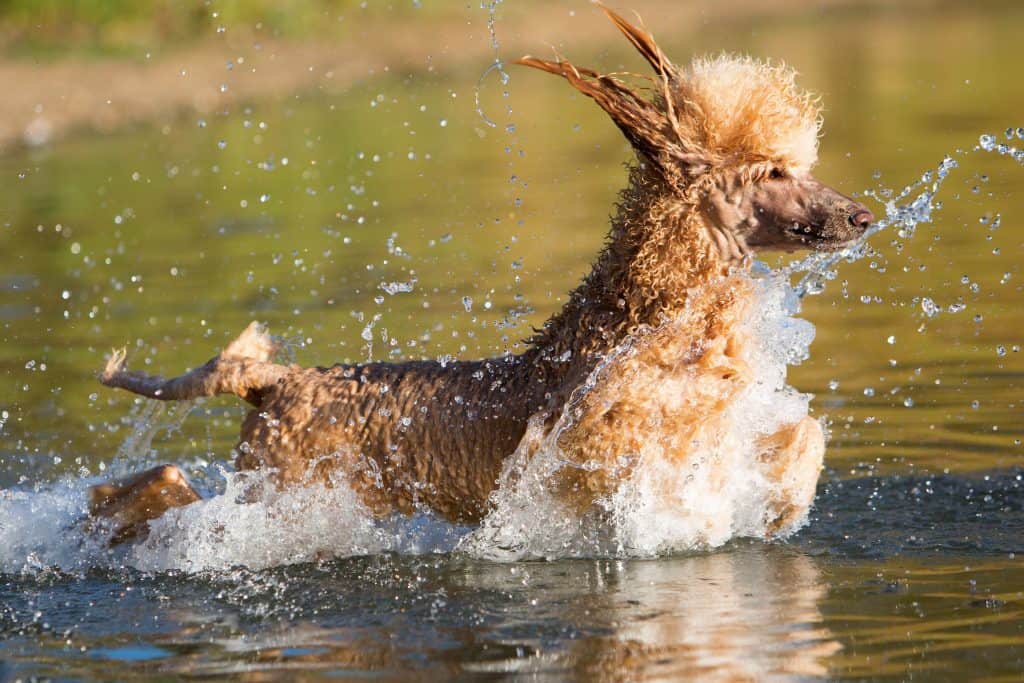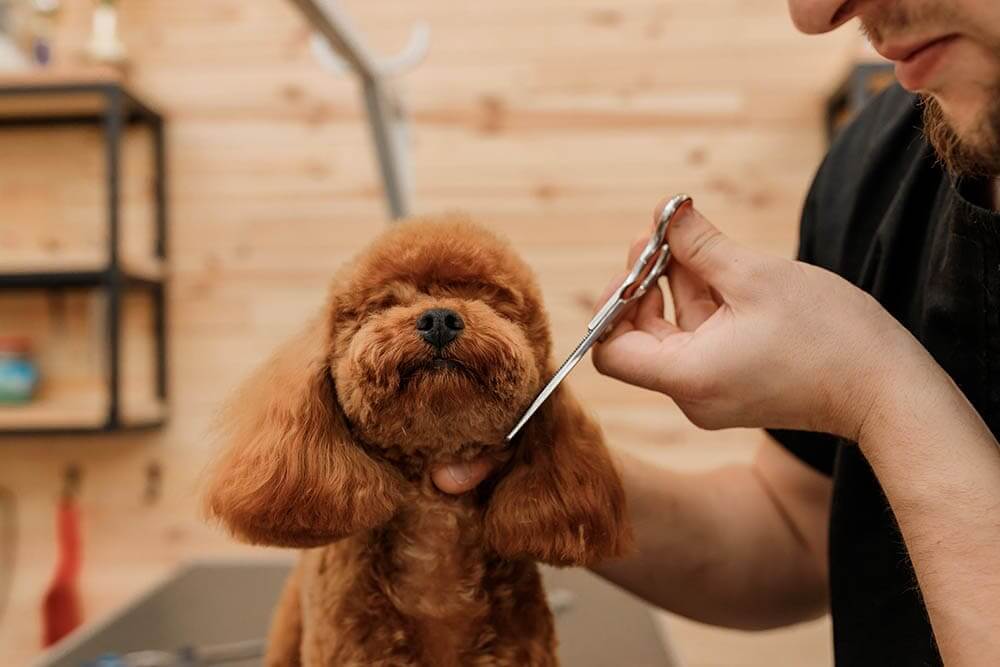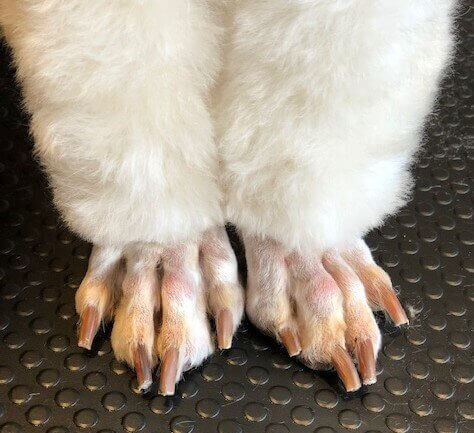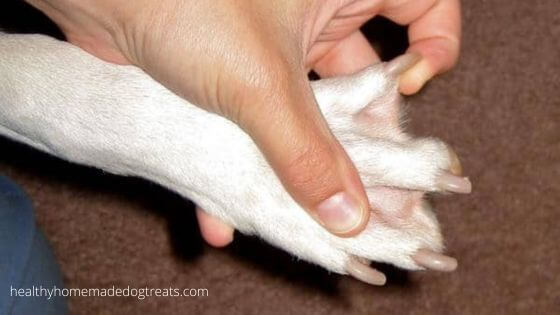Poodles are famed for their outstanding intelligence and ease of training. They are friendly, fun-loving, and happy dogs who are always ready to please their owners.
When poodles are mentioned, you may think of their curly coats, long pointed noses, small dark eyes, and the topiary continental clip—the famous grooming style which leaves beautiful curly pom-poms of hair around the chest and joints.
What you might not know or imagine is that poodles have another hidden but important feature: webbed feet!
It is an anatomical adaptation feature to enable them to swim better and faster in water. Essentially, the webbings are membranes in the middle of the dog’s toes and are believed to allow these dogs to wade through water fast and efficiently.
Read on to find out what this trait is, why poodles have the trait, whether all poodles have the trait, benefits, other breeds that share this fascinating feature, and how to take care of your poodle’s webbed feet.
What Is Webbed Feet In Dogs?
The term ‘’webbed feet” is often used to refer to connective tissues or membranes that connect each toe in animals.
The connective tissues may cover just the toes or the entire foot.
It is an anatomical adaptation to increase the surface area of the foot, thereby helping the animal to push against the water while moving.
The extent of webbing depends on how much time an animal spends in the water. Webbing in ducks, flamingos, beavers, frogs, and otters are, therefore, more pronounced.
Since dogs only spend minimal time in the water, breeds that have webbed feet only manifest partial or less pronounced webbing.
But like other animals with the webbing feature, dogs with webbed feet are excellent swimmers—with the potential to paddle considerably longer distances in water without drowning.
Fun Fact:
All dogs are born with webbed feet but only a few keep them in their entire lives. Many dog breeds grow out the feature as they get older.
The dogs that keep them in their entire lives are due to adaptation forces—the webbing helps them to accomplish certain tasks that are related to their respective breeds.
Water dogs, for instance, have webbed feet to boost their agility in the water.
Why Poodles Have Webbed Feet
So, why do poodles have webbed feet or why do they keep the webbing feature in their entire life?
Well, it is believed to be because of a scientific concept called natural selection. This is a term that is used to refer to a process or a trait in animals that tend to be more pronounced in a population over time to enable them to survive and reproduce.
The process may even lead to the evolution of other new traits—and even other new species—over time. The species with the trait have higher chances of thriving in a given environment than those without, making the trait to be more common in the population over time.
Based on this analogy, poodles are believed to have webbed feet because they were initially bred to be water retrievers (they were used to bring ducks and other water birds to their masters or hunters).
Another possible reason why poodles and other dogs with webbed feet still have the trait is selective breeding.
Throughout history, humans have been trying to get the best traits in their four-legged companions.
Consequently, there is a possibility that some people could have bred more pronounced webbing into their dogs over time.
Because poodles were bred to be water retrievers, we cannot rule out the possibility of selective breeding because at least we understand what the extra enhancement could add to the breed.
Do All Poodles Have Webbed Feet?
Yes, all poodles have webbed feet. While you cannot rule out the presence of genetic variability within the breed, the webbing feature is breed-wide.
Considering that webbing boosts a dog’s agility in the water, it is more common in breeds that were originally bred for water-related tasks, such as the Poodle.
That said, the extent of webbing may vary from one poodle to another.
See, the webbing trait is controlled by a number of genes—some of which are dominant and others recessive.
So, whether or not your poodle has more or less pronounced webbed feet depends on his or her genetic makeup.
Benefits of Having Webbed Feet

Besides making them better swimmers, there are a few other benefits to having webbed feet for Poodles, including:
- Improved balance and traction in muddy, icy or swampy areas
- Aids in digging and retrieving underground prey
- Keeping them cool during hot weather because of the increased surface area of the paws
- Protect the feet from becoming too cold as a dog wades or work in cold weather.
How To Checking the Extent of Webbing in Your Poodle
Does your poodle have a more or less pronounced webbed feet?
Well, if you are curious to know, just look at his paws and gently separate the toes.
As you splay out the paws, you can establish the extent the flap of skin or membrane has stretched between his individual toes.
Your poodle’s webbing is more pronounced if it runs all the way to his nails and less pronounced if the membrane is much shorter or closer to the top of your pup’s foot.
Other Dogs with Webbed Feet
Apart from poodles, there are many other dogs with webbed feet. These include:
- Newfoundland
- Redbone Coonhounds
- Brussels Griffons
- Akitas
- Field Spaniels
- Otterhounds
- German Wirehair Pointers
- Nova Scotia Duck-Tolling Retriever
- Chesapeake Bay retriever
- Portuguese water dog
- Irish Water Spaniel
- Dachshund
- Weimaraners
- German Shorthair Pointers
- Wire-haired Pointing Griffons
Grooming and caring for your Poodle’s webbed Feet

When grooming your poodle, consider spreading his toes gently to ensure that there is no injury to the webbing membranes or tissues.
You should also be extra careful when using tools like clippers, combs, and brushes around your poodle’s feet. Be as gentle as necessary to avoid potential injuries.
Lacerations, abrasions, infections, and other issues can occur on a dog’s paw—whether they have webbed feet or not.
To ensure that your poodle paws are healthy, check them (including the webbing membranes) a few times a week.
In summary
Poodles have webbed feet. This feature is what makes them excellent swimmers—the webbed paws allow the dogs to be quick and precise while wading through water.
If you are surprised by this unique feature of poodles, I hope that seeing their benefits in real life can make you come to terms with the reality.
Else, staring into your pup’s adoring and sweet face will make you forget about any funny association that you may have with animals with webbed feet.
Planning to welcome a new puppy into your home but confused about whether to choose one with webbed feet or one without?
Don’t fret because we have your back…we already have a post that can help you make the right decision. Check it out: Webbed Dog Feet vs. Non-Webbed: Should It Be a Concern When Getting a New Puppy?
As an Amazon Associate, we may receive a small commission from qualifying purchases but at no extra cost to you. Learn more. Amazon and the Amazon logo are trademarks of Amazon.com, Inc, or its affiliates.



